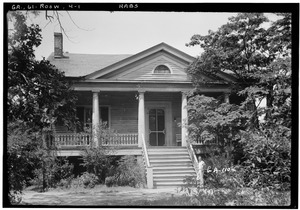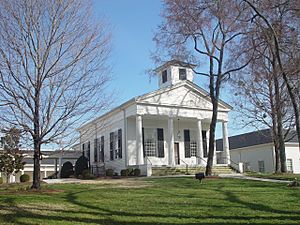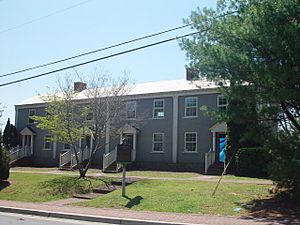Roswell Historic District (Roswell, Georgia) facts for kids
Quick facts for kids |
|
|
Roswell Historic District
|
|
| Location | Roughly bounded by Big Creek, King and Dam Sts., SW along New Marietta Hwy., Roswell, Georgia |
|---|---|
| Area | 120 acres (49 ha) |
| Built | 1837-1900s |
| Built by | Willis Ball |
| Architect | Willis Ball |
| Architectural style | Greek Revival, Late Georgian |
| NRHP reference No. | 74000682 |
| Added to NRHP | May 2, 1974 |
The Roswell Historic District is a special area in Roswell, Georgia, located in Fulton County. It was added to the National Register of Historic Places in 1974. This means it's recognized as an important historical place in the United States.
The district covers about 120 acres (49 hectares). It's generally found near Big Creek, King and Dam Streets, and along New Marietta Highway in Roswell. Many of the buildings in this area were built a long time ago, starting as early as 1837.
Willis Ball, an architect and builder from Connecticut, helped create four important buildings here: Primrose Cottage, Roswell Presbyterian Church, Bulloch Hall, and Barrington Hall.
Exploring the Roswell Historic District
The Roswell Historic District is home to 28 important buildings and three structures that show off old building styles like Greek Revival architecture and Late Georgian architecture. It also includes the Roswell town square, which is a historic site.
Famous Buildings You Can See
Many interesting places are part of this historic district. Here are some of them:
Bulloch Hall (1839)
Bulloch Hall was built in 1839. It's a grand old house that was also listed on the National Register of Historic Places in 1971, even before the whole district was.
Barrington Hall (1839)
Barrington Hall, also built in 1839, is another important house in the district. It was also listed on the National Register in 1971.
Roswell Town Square
The Roswell Town Square is a central part of the district. Some people have called it "the Boston Common of this most southern of New England villages." It has historic monuments that tell stories of the past.
Mimosa Hall (1847)
Mimosa Hall, also known as Phoenix Hall, was built in the Greek Revival style. It was first built in 1840 for an early Roswell settler, John Dunwoody. After a fire, it was rebuilt in 1847. Later, it was named Mimosa Hall by General A. J. Hansell. In 1916, a famous Georgia architect named Neel Reid bought it and designed new parts for the house and its gardens. The Hansell family owned it again for many years. In 2017, the city of Roswell bought the property. There are plans to make this old mansion into a "net zero" home, which means it would produce as much energy as it uses!
Holly Hill (1842-1847)
Holly Hill, also called the Lewis Place, was built between 1842 and 1847. It's a Greek Revival style house facing the town square. It was built as a summer home for a cotton broker from Savannah named Robert Adams Lewis and his wife.
Primrose Cottage (c.1839)
Primrose Cottage was built around 1839 on Mimosa Boulevard. It's one of the very old homes in the area.
Great Oaks (1842)
Great Oaks, built in 1842 on Mimosa Boulevard, is now used as a wedding venue called "The Gardens at Great Oaks."
Roswell Presbyterian Church (1840)
The Roswell Presbyterian Church was built in 1840. The church group itself started at Primrose Cottage in 1839. Nearby, there's also the church's cemetery, which dates back to 1841.
The Old Bricks
The Old Bricks were originally homes for the people who worked at the Roswell Mills. These buildings show how people lived and worked in the past.
Southern Mills Building (1882)
The Southern Mills building on Mill Street has a long history. The original mill was destroyed in 1864. It was rebuilt in 1882, but then destroyed by lightning in 1929. Even after that, it kept operating until 1975.
Old Mill (c.1840)
The Old Mill, located off Mill Street on Big Creek, is a two-story brick building. It's the last remaining part of the original Roswell Manufacturing Company, which started in 1839. Today, it's part of the "Old Mill Park and Machine Shop."




